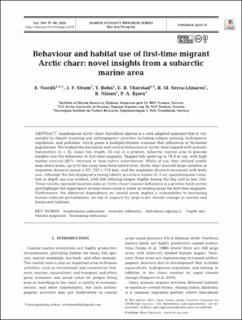Behaviour and habitat use of first-time migrant Arctic charr: novel insights from a subarctic marine area
Nordli, Eivind; Strøm, John Fredrik; Bøhn, Thomas; Thorstad, Eva Bonsak; Serra Llinares, Rosa Maria; Nilsen, Rune; Bjørn, Pål Arne
Peer reviewed, Journal article
Published version
Date
2023Metadata
Show full item recordCollections
- Articles [3009]
- Publikasjoner fra CRIStin [3056]
Abstract
Anadromous Arctic charr Salvelinus alpinus is a cold-adapted salmonid that is vulnerable to climate warming and anthropogenic activities including salmon farming, hydropower regulation, and pollution, which poses a multiple-stressor scenario that influences or threatens populations. We studied the horizontal and vertical behaviour of Arctic charr tagged with acoustic transmitters (n = 45, mean fish length: 22 cm) in a pristine, subarctic marine area to provide insights into the behaviour of first-time migrants. Tagged fish spent up to 78 d at sea, with high marine survival (82% returned to their native watercourse). While at sea, they utilized mostly near-shore areas, up to 45 km away from their native river. Arctic charr showed large variation in migration distance (mean ± SD: 222 ± 174 km), and the migration distance increased with body size. Although the fish displayed a strong fidelity to surface waters (0-3 m), spatiotemporal variation in depth use was evident, with fish utilizing deeper depths during the day and in late July. These results represent baseline data on Arctic charr’s marine behaviour in a pristine fjord system and highlight the importance of near-shore surface water as feeding areas for first-time migrants. Furthermore, the observed dependency on coastal areas implies a vulnerability to increasing human-induced perturbations, on top of impacts by large-scale climate change in marine and freshwater habitats.
